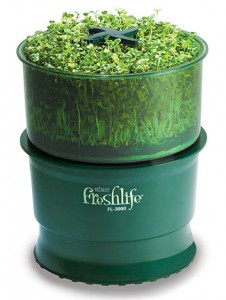Microgreens Are Sprouting Superfood

Sprouts have a come a long way since the 1970s. Back then, only hippies and health nuts ate sprouts. Today, almost everyone is a health nut—interested in prolonging life, feeling as good as possible, and looking as young as can be. Because of that, chefs and foodies have decided to take another look at home sprouting. Of course, today the preferred term is “microgreens,” but really that includes baby shoots from vegetables, or beans, or seeds, or even grains.
Sprouts, or microgreens, are very healthy because they contain all of the nutrients of bigger, adult plants in their young, tender shoots. For instance, we know that broccoli contains cancer-fighting compounds like isothiocyanates—in particular, sulforaphane or SFN. Oregon State University’s Linus Pauling Institute of Micronutrient Information has this to say about broccoli sprouts: “The amount of glucoraphanin, the precursor of SFN, in broccoli seeds remains more or less constant as those seeds germinate and grow into mature plants. Thus, 3-day old broccoli sprouts are concentrated sources of glucoraphanin, which contain 10-100 times more glucoraphanin by weight than mature broccoli plants.” This kind of nutrient density is what makes sprouts and microgreens so valuable.
Sprouts are also easier to digest than their mature-plant counterparts because once germinated, a seed’s components are broken down from the complex to the simple form. For instance, protein gets broken down into amino acids during the sprouting phase. Fats get broken down into fatty acids. Starches become sugars. And minerals combine with proteins in a way that makes them more bioavailable.
Generally speaking, sprouts are germinated in water under low light conditions while micro-greens are grown in soil in regular light. Sprouts can be eaten with their roots attached, but it’s probably safer to trim the roots off before eating so that the seed hulls caught in the roots aren’t ingested. Roots and seed hulls can harbor bacteria if not properly rinsed. Germinating sprouts at home requires constant soaking and rinsing and aerating in order to keep them clean and free of pathogens. Seeds can be germinated in soil or in small containers, or sprouted in water using a sprouting machine.
 I bought a sprouting machine from Freshlife so that I could have fresh sprouts for my salads and stir-fries and sandwiches. I use only organic seeds. They can be purchased online at www.sproutman.com I like broccoli, mung bean, wheat grass, fenugreek, and alfalfa sprouts. I place my seeds inside the Freshlife sprouter and fill it with distilled water. I can sprout two or three varieties of seeds at one time, as long as they have similar harvesting periods. The machine will sprinkle the sprouts with water at regular intervals. It also drains excess water and keeps the sprouts aerated so I don’t have to worry about bacteria growing. If you sprout seeds at home without a machine, you have to water them twice a day and change the water every day yourself.
I bought a sprouting machine from Freshlife so that I could have fresh sprouts for my salads and stir-fries and sandwiches. I use only organic seeds. They can be purchased online at www.sproutman.com I like broccoli, mung bean, wheat grass, fenugreek, and alfalfa sprouts. I place my seeds inside the Freshlife sprouter and fill it with distilled water. I can sprout two or three varieties of seeds at one time, as long as they have similar harvesting periods. The machine will sprinkle the sprouts with water at regular intervals. It also drains excess water and keeps the sprouts aerated so I don’t have to worry about bacteria growing. If you sprout seeds at home without a machine, you have to water them twice a day and change the water every day yourself.
Once the seeds grow to a height of about 4 or 6 inches and have two tiny leaves, they are ready to harvest. For radish, kale, turnip, and mustard seeds this takes only 5–6 days. Alfalfa and clover seeds take about 7 days to mature. Buckwheat, fenugreek, red pea, sunflower, and wheatgrass seeds take 8–12 days to reach maturity. Garlic, onion, chia, and psyllium seeds need 12–14 days to sprout. (Sprouting schedule courtesy of Sprouts: The Miracle Food by Steve Meyerowitz.) I simply cut the sprouts off the seed tray and store them in my refrigerator for up to a week. Or I eat the tender greens right away in a salad or a sandwich wrap.
 Seeds that generate a gelatinous covering when soaked shouldn’t be sprouted in a plastic tray like the one in my Freshlife sprouter. Those need to be grown on clay. Gelatinous seeds include arugula, chia, cress, psyllium, and flaxseeds, and yellow mustard seeds. A chia pet, believe it or not, is really the best vehicle for sprouting these kinds of seeds. To grow your own microgreens at home, you can use a handy kit from a company called ThinkMint. This kit includes a germination pad that stands in for soil. You sprinkle your favorite seeds on the pad, water them, and watch them grow on your kitchen countertop. The microgreen crops are ready in 10–20 days. Here’s a recipe from the ThinkMint website:
Seeds that generate a gelatinous covering when soaked shouldn’t be sprouted in a plastic tray like the one in my Freshlife sprouter. Those need to be grown on clay. Gelatinous seeds include arugula, chia, cress, psyllium, and flaxseeds, and yellow mustard seeds. A chia pet, believe it or not, is really the best vehicle for sprouting these kinds of seeds. To grow your own microgreens at home, you can use a handy kit from a company called ThinkMint. This kit includes a germination pad that stands in for soil. You sprinkle your favorite seeds on the pad, water them, and watch them grow on your kitchen countertop. The microgreen crops are ready in 10–20 days. Here’s a recipe from the ThinkMint website:
Radish Microgreen Hummus
1 cup radish microgreens
1 Tbsp. tahini
1 Tbsp. lemon juice
1 tsp. olive oil
1 clove garlic (or more to taste)
1 tsp. ground cumin
½ tsp. salt
½ tsp. ground white pepper
1. Place all ingredients in a food processor. Blend until smooth. Add additional liquid as needed for desired consistency.
2. Serve with crackers, tortilla chips, or cut-up veggies. Store any leftover hummus in the refrigerator.
Certain sprouts—those from beans or grains—should be cooked before eating. A good rule of thumb to follow is this: if it develops a green leaf, it’s okay to eat raw. Sprouts from mung beans, lentils, chickpeas, green peas, soybeans, adzuki beans, red peas, pinto beans, navy beans, and kidney beans still look like beans (albeit with a long tail) after sprouting and should be cooked before eating. Larger bean sprouts can be boiled, although for a much shorter time than their dried-bean counterparts. Smaller bean sprouts are great when lightly sautéed or wok cooked. Sprouts from grains like wheat, rye, oat, millet, barley, and corn are too tough to digest unless ground and baked first, or thoroughly juiced.

